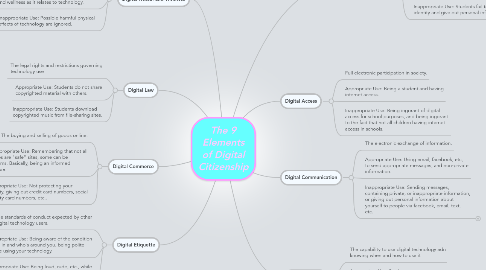The 9 Elements of Digital Citizenship
作者:Lindsey A.


1. Digital Commerce
1.1. The buying and selling of goods online.
1.2. Appropriate Use: Remembering that not all sites are "safe" sites, some can be scams. Basically, being an informed buyer.
1.3. Inappropriate Use: Not protecting your identity, giving out credit card numbers, social security card numbers, etc..
2. Digital Etiquette
2.1. The standards of conduct expected by other digital technology users.
2.2. Appropriate Use: Being aware of the condition your in and who's around you, being polite while using your technology.
2.3. Inappropriate Use: Being loud, rude, etc., while using technology.
3. Digital Law
3.1. The legal rights and restrictions governing technology use
3.2. Appropriate Use: Students do not share copyrighted material with others.
3.3. Inappropriate Use: Students download copyrighted music from file-sharing sites.
4. Digital Health and Wellness
4.1. The elements of physical and psychological well-being related to digital technology use
4.2. Appropriate Use: Students learn about health and wellness as it relates to technology.
4.3. Inappropriate Use: Possible harmful physical effects of technology are ignored.
5. Digital Access
5.1. Full electronic participation in society.
5.2. Appropriate Use: Being a student and having internet access.
5.3. Inappropriate Use: Being ingorant of digital access for school purposes, and being ingorant to the fact that not all children having internet access in schools.
6. Digital Communication
6.1. The electronic exchange of information.
6.2. Appropriate Use: Using email, facebook, etc, to send appropriate messages, and non-private information.
6.3. Inappropriate Use: Sending messages, containing private, or inappropriate information, or giving out personal information about yourself to people via facebook, email, text, etc.
6.3.1. New node
